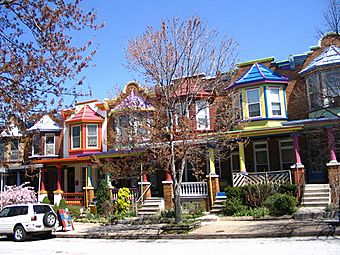Charles Village, Baltimore facts for kids
Quick facts for kids
Charles Village
|
|
|---|---|
|
Neighborhood of Baltimore
|
|
| Country | United States |
| State | Maryland |
| City | Baltimore |
| Established | 1897 as Peabody Heights 1967 as Charles Village |
| Population
(2010)
|
|
| • Total | 8,267 |
| • Density | 25,159/sq mi (9,714/km2) |
| Demonym(s) | Charles Villager |
| Time zone | UTC-5 (Eastern) |
| • Summer (DST) | EDT |
| ZIP code |
21218
|
| Area code | 410, 443, and 667 |
|
Charles Village-Abell Historic District
|
|

Guilford Avenue rowhouses
|
|
| Location | Roughly bounded by University Parkway, Guilford Ave., and 25th, Mace, Charles, and Barclay Sts., Baltimore, Maryland |
| Area | 175 acres (71 ha) |
| Built | 1868 |
| Architect | Multiple |
| NRHP reference No. | 83003629 |
| Added to NRHP | December 15, 1983 |
Charles Village is a lively neighborhood in north-central Baltimore, Maryland, USA. It's known for being a diverse and welcoming place. Many families live here in homes built a long time ago.
This area is close to many cool places in Baltimore. You can find the Baltimore Museum of Art nearby. The Johns Hopkins University Homewood campus is also right here. There's also Wyman Park and a weekly farmers market.
The neighborhood started in 1869 as "Peabody Heights." Builders bought land and constructed the outside of homes. Buyers then designed the inside themselves. In the early 1900s, it became a "streetcar suburb." This meant people could easily get around using streetcars. The name "Charles Village" came about in the 1970s. It's named after Charles Street, a main road.
Contents
Who Lives in Charles Village?
One big reason Charles Village is special is its closeness to the Johns Hopkins University. Many students and staff from the university live here. This means you'll find lots of creative people and artists.
The neighborhood is also known for being very diverse. People from many different backgrounds live side by side. This is unique in a city that used to be separated by race. The homes tend to be fancier as you go north and west.
Homes in Charles Village
Most homes in Charles Village are two or three stories tall. They are called rowhouses and were built in the early 1900s. Many of these homes are well-kept and have become more valuable. Some larger rowhouses have been turned into apartments.
The Famous Painted Ladies
In 1998, something fun happened in Charles Village. Residents were asked to paint their Victorian-style homes with bright, unusual colors. This led to over 100 homes being painted in just five years! There were even contests with prizes for the best-painted porches or front doors.
These contests ended in 2003, but the colorful homes remain. They are now called the "Painted Ladies." Pictures of these homes are often seen on travel guides. They have become a famous part of Baltimore.
Fun Things to Do and New Developments
Charles Village has several small shopping areas. You can also walk to the popular Waverly farmer's market. This market is a great place to find fresh food.
New things are always happening here. In 2006, a new Barnes & Noble bookstore opened. It's part of a new dorm building for Hopkins students called Charles Commons. This project also added new condominiums with shops on the ground floor. The bookstore serves both university students and local residents.
The Benefits District
Charles Village has a special group called the Charles Village Community Benefits District Management Authority (CVCBDMA). It's one of a few special districts in Baltimore. This group helps keep the neighborhood clean and safe.
Property owners in the area pay a small extra tax. This money helps pay for services like extra trash pickup and safety programs. The CVCBDMA also supports community events. Their goal is to make Charles Village a great place to live.
A Taste of Korea
A small part of lower Charles Village is sometimes called Koreatown or Little Korea. It's not an official name, but you'll find many Korean restaurants here. This area is popular with Korean students from Johns Hopkins University. They come here for delicious Korean food.
Little Appalachia's History
Long ago, a part of Charles Village was known as "Little Appalachia." This was home to people who moved to Baltimore from the Southern and Appalachian regions. Many of these newcomers settled here after World War II. They often came looking for work. Famous bluegrass musician Hazel Dickens lived in this area.
Getting Around Charles Village
Getting around Charles Village is easy! Several MTA Maryland bus routes serve the area. These include Route 11, Route 3, and Route 8. They can take you to places like Towson.
The Charm City Circulator also has stops on St. Paul Street and Charles Street. This free bus service helps people travel around the city. The Johns Hopkins Shuttle is also available. It takes students and staff between the Homewood campus and the Johns Hopkins Hospital.
Major roads like Charles Street and St. Paul Street run through the neighborhood. These are important routes for cars. The area is also close to the Jones Falls Expressway (I-83), making it easy to drive to other parts of the city.
Images for kids
-
University Parkway borders the Johns Hopkins University Homewood campus



